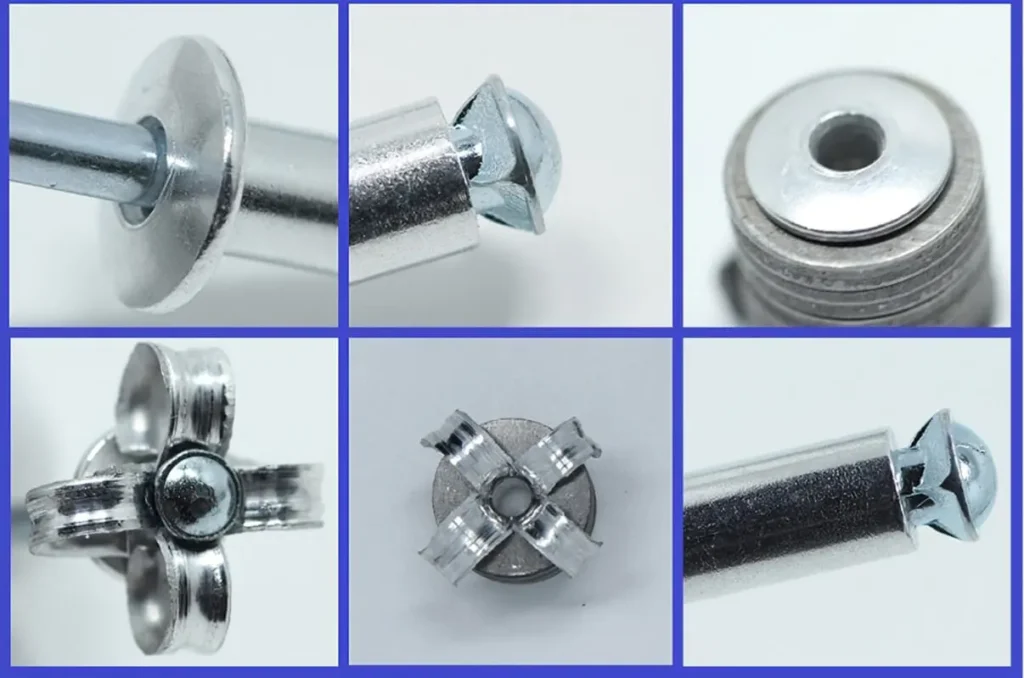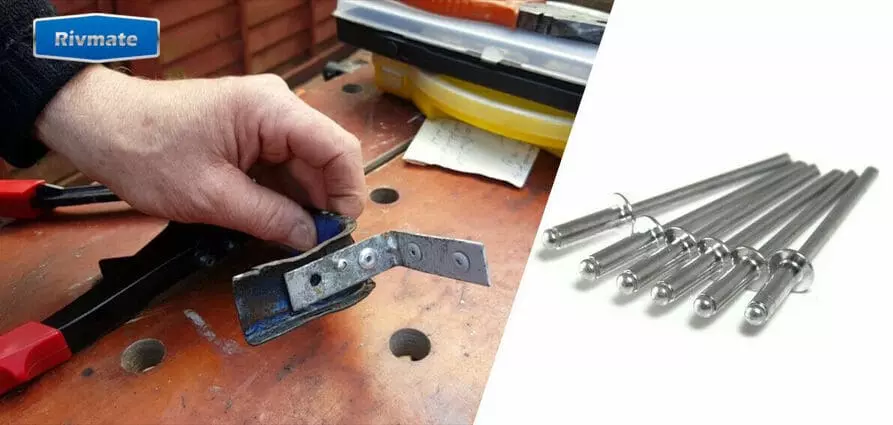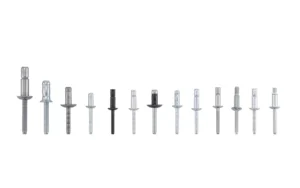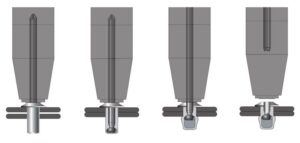How to Choose Blind Rivets for Soft Materials?
Table of Contents
In the manufacturing and assembly processes, soft materials such as plastics, woods, composite boards, and thin aluminum sheets are widely used in the automotive, home appliance, and construction industries. However, these materials have low density and limited strength, and the use of traditional rivets often leads to “piercing through”, “deformation”, or “connection failure”. How to correctly select and install blind rivets for soft materials? This blog will delve into the key technical points of riveting soft materials to help you find the most suitable low-density fastening solution.
Understanding Soft Materials in Riveting Applications

In fastening technology, Soft Materials typically refer to substrates with low density, low yield strength, and prone to plastic deformation. Such materials include plastic, wood, aluminum alloy, FRP (fiberglass reinforced plastic), PVC (polyvinyl chloride), and carbon fiber composites, etc.
They have obvious flexibility and compressibility, and are prone to problems such as collapse, deformation or tearing, especially in the concentrated force area of the riveting. Due to the structural characteristics of these materials, the expansion force of traditional metal rivets is often too large, which may damage the surface of the base material or cause stress concentration.
When riveting soft materials, engineers need to strictly control the expansion path and clamping force of the rivets to achieve a secure connection without damaging the material. This is also the key to choosing Blind Rivets specifically designed for soft materials.
Why Standard Blind Rivets Fail in Soft Materials

When connecting low-density substrates such as plastics, woods or composite materials, traditional Blind Rivets often fail to achieve the desired tightening effect. This is because their structure and load-bearing characteristics are not designed for flexible or compressible materials.
- The tail is unevenly expanded, which makes it prone to concentrating stress.
During the self-drilling riveting process of standard rivets, the tail part will undergo axial deformation and expansion. However, in soft substrates, this local expansion will form a “high stress concentration area”, causing the material to “tear” or the surface to collapse. - Excessive clamping force or insufficient friction.
When the rivets exert excessive force on the soft material, the surface of the material is prone to being crushed or undergoing permanent deformation; conversely, if the friction is insufficient, the connection will gradually loosen. - The contact area is too small, resulting in uneven force distribution.
The head and tail of the standard rivet both adopt a “point contact structure”, which limits the supporting area for flexible materials. The lack of sufficient pressure-bearing surfaces leads to the concentration of clamping force, thereby reducing the overall durability and anti-detachment capability.
In soft materials, it is advisable to opt for specific types of rivets that have a large contact surface or a split tail design, such as Peel Type or Large Flange Rivets, in order to distribute the stress and extend the service life of the connection.
Best Blind Rivet Types for Soft Materials
When connecting flexible substrates such as plastic, wood, composite boards or thin aluminum, choosing the appropriate type of Blind Rivet is crucial for ensuring the reliability and durability of the connection. Different types of rivets will affect the distribution of forces, the stability of clamping, and the crack resistance. The following are several high-performance solutions designed by Rivmate for soft materials:



| Type | Structural Features | Suitable Materials | Key Advantages | Recommended Rivmate Model |
|---|---|---|---|---|
| Peel Type Rivet | The rivet body splits into “petal” shapes during installation, creating a wide bearing area. | Plastic, wood, composite panels | Prevents pull-through and evenly distributes stress. | Rivmate P-Series |
| Large Flange Rivet | Features a larger head surface for better load distribution and reduced surface pressure. | Thin sheets, soft metals, PVC panels | Increases bearing area and prevents local deformation. | Rivmate L-Series |
| Multi-Grip Rivet | Designed to accommodate a wide range of material thicknesses. | Composites, plastic-to-aluminum assemblies | Reduces inventory variety and ensures stable connections. | Rivmate M-Series |
| Soft-Grip Rivet | The tail forms a “bowl shape” that absorbs deformation stress. | Foam boards, plastics | Absorbs energy, prevents cracking, and protects soft substrates. | Rivmate S-Series |
In the riveting of soft materials, the contact area and the shape of the tail expansion determine the success or failure of the connection.
- If the substrate is relatively soft (such as ABS, PVC), it is recommended to use Peel Type or Soft-Grip Rivet.
- If you want to balance both structural strength and surface integrity, you can choose Large Flange Rivet.
- For modular production lines or assembly of multi-thickness plates, the Multi-Grip Rivet is preferred to enhance assembly efficiency and reduce inventory.
Material Compatibility for Soft Material Riveting
When choosing a Blind Rivet suitable for soft materials (such as plastic, wood or composite boards), the material compatibility of the rivet itself is of utmost importance. There are issues such as electrochemical reactions, hardness differences, and inconsistent thermal expansion coefficients between different metals. Ignoring these factors may result in corrosion, electrochemical reactions or damage to the substrate.
| Rivet Material | Recommended Base Material | Key Characteristics & Advantages |
|---|---|---|
| Aluminum | Plastic, wood, aluminum sheet | Lightweight and corrosion-resistant; no galvanic reaction with aluminum substrates; ideal for soft or delicate surfaces. |
| Steel (Zinc-Plated) | Composites, steel inserts | High strength and cost-effective; requires protective coating to prevent rust. |
| Stainless Steel (304 / 316) | FRP, PVC, composite panels | Excellent corrosion and fatigue resistance; suitable for humid, coastal, or outdoor environments. |
| Copper / Brass | Electrical components, decorative structures | Superior electrical conductivity and ductility; ideal for electrical connections and aesthetic applications. |
- For soft or low-density materials (such as plastic and wood), it is recommended to use aluminum rivets or large flange structures to reduce surface indentation and local stress concentration.
- Avoid using hard materials (such as stainless steel) for direct riveting of flexible substrates, as these rivets may penetrate or damage the surface during the riveting process.
- In situations requiring stronger support, a backing washer can be added or Rivmate Large Flange Rivets can be used to significantly improve the force distribution.
Proper Installation Techniques for Blind Rivets in Soft Materials
When connecting flexible or low-density materials such as plastic, wood, and composite boards, even if the appropriate type of rivets is selected, improper installation can still lead to material cracking, collapse, or loosening of the connection. The following are the key operational points summarized by the Rivmate engineering team, which can significantly enhance the installation reliability and structural lifespan.
① Hole Size Accuracy
The hole size should be approximately 0.1–0.2mm larger than the diameter of the rivet body. If the holes are too small, the material will be compressed and deformed; if the holes are too large, the clamping force will be reduced and the parts may become loose. It is recommended to use high-precision drill bits or limiting drilling tools to ensure consistency.

② Install backing washers
For thinner or softer materials, a Backing Washer should be added on the back side. This component can significantly distribute the tension, preventing the tail of the rivet from “penetrating” or tearing the material.
Rivmate offers compatible gaskets in aluminum, stainless steel and nylon materials.
③ Controlled Speed & Force

When using pneumatic or electric riveting guns, it is recommended to set lower pulling force and speed. Excessive core shaft stretching can cause local heating and stress concentration of the material, especially in plastic substrates, where it is prone to cracking.
④ Use Anti-Slip Rivet Tools
It is recommended to use the Rivmate electric riveting gun with a torque control system, which can prevent problems such as slipping teeth, uneven pulling force, or unstable rivet rotation. A stable riveting process helps to achieve a consistent expansion form.
⑤ Post-Installation Inspection
After the installation is completed, the following should be checked:
- Is the tail of the rivet evenly expanded?
- Is the top part flat and properly fitted?
- Is there no crack or local collapse on the surface of the base material?
When connecting flexible materials such as plastic, wood or composite boards, even if the appropriate type of rivets is selected, if the installation or selection is improper, problems such as cracks, loosening or failure are prone to occur. The following are the typical problems and improvement methods summarized by the Rivmate engineering team based on thousands of experiments and customer cases:
Question 1: Material Cracking due to Rivet Pulling
Reason Analysis: The tail end of the standard rivet undergoes concentrated expansion, resulting in excessive stress and causing the material to rupture.
Solution: Choose Peel Type Rivet or Large Flange Rivet, as these structures can distribute the pressure and prevent material tearing or surface collapse.
Question 2: Loose Joint or Weak Grip
Reason Analysis: The grip range of the rivet does not match, or there is a significant difference in the thickness of the substrate.
Solution: Switch to Multi-Grip Rivet, which can automatically compensate for thickness variations and maintain a stable clamping force. It is suitable for structures with large assembly tolerances.
Question 3: Backside Collapse or Pull-Through
Reason Analysis: Lack of supporting surface. During riveting, the tail end is directly pressed into the soft substrate.
Solution: Add a Backing Washer on the back, or use a Soft-Grip Rivet, with the “cup-shaped” design at the tail to buffer stress and prevent the structure from loosening.
FAQ
Sure, but you need to choose the models specifically designed for soft substrates. For example, Rivmate’s P-Series Splitting Bolts or L-Series Large Flange Bolts. They can distribute the stress and prevent the material from being pulled apart or crushed.
Q2: How do I prevent rivets from cracking soft materials?
The key lies in controlling the installation force and choosing the appropriate structure. By using low-speed riveting tools, adding backing washers, or adopting Soft-Grip type rivets, stress concentration and thermal deformation can be effectively reduced.
Q3: Which rivet type is best for PVC or FRP panels?
It is recommended to use Peel Type Rivet or Multi-Grip Rivet. These types of rivets can form a wide tail support surface in composite boards and plastic structures, preventing the separation of board layers and providing a stronger connection.
Q4: Are large flange rivets stronger for soft materials?
Yes. The large flange design can significantly increase the force-bearing area, reducing the risks of local indentation and tearing.
Q5: Do I need washers when riveting soft materials?
It is recommended to use. The gasket can distribute the stress on the back, preventing the head of the rivet from “getting stuck” or being pulled through. Rivmate offers Backing Washer in various materials such as aluminum, stainless steel, and nylon, suitable for different environments and substrate hardness.
Build Strong Connections on Soft Materials
In soft materials such as plastic, wood or composite boards, the key to connection is not “higher strength”, but “better structural fit”. By choosing blind rivets with wide contact surface (Large Flange), flexible tail (Peel or Soft-Grip Design) and appropriate gripping range (Correct Grip Range), it is possible to effectively prevent material rupture, stress concentration and long-term loosening, thus achieving safe and reliable permanent fixation.
Explore Rivmate Engineering Fastening Center

Visit the Rivmate Engineering Fastening Center to obtain specialized rivet solutions suitable for plastics, wood, and composite materials. Or contact the Rivmate engineering team to obtain your customized fastening solutions and technical support.
Reference

How to Rivet Metal to Wood?
How to Rivet Metal to Woo

What Is Riveting in Metal Work?
What Is Riveting in Metal

What Metal Are Rivets Made Of
What Metal Are Rivets Mad

How to Rivet Metal to Metal
How to Rivet Metal to Met







